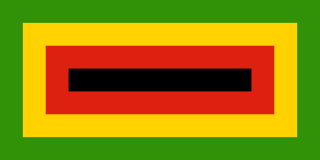
The Selous Scouts was a special forces unit of the Rhodesian Army that operated during the Rhodesian Bush War from 1973 until the reconstitution of the country as Zimbabwe in 1980. It was mainly responsible for infiltrating the black majority population of Rhodesia and collecting intelligence on insurgents so that they could be attacked by regular elements of the security forces. The unit did this by forming small teams that posed as insurgents and usually included captured insurgents. Over time, the Selous Scouts increasingly attacked insurgents themselves and operated in the countries that neighboured Rhodesia.

RENAMO is a Mozambican political party and militant group. The party was founded with the active sponsorship of the Rhodesian Central Intelligence Organisation (CIO) in May 1977 from anti-communist dissidents opposed to Mozambique's ruling FRELIMO party. RENAMO was initially led by André Matsangaissa, a former senior official in FRELIMO's armed wing, and was composed of several anti-communist dissident groups which appeared immediately prior to, and shortly following, Mozambican independence. Matsangaissa, who died in 1979, was succeeded by Afonso Dhlakama, who led the organization until he died in 2018. He was succeeded by Ossufo Momade.
Operation Dingo, or the Chimoio Massacre , was an attack by the Rhodesian Security Forces against the Zimbabwe African National Liberation Army (ZANLA) run camps at Chimoio and Tembue in Mozambique from 23 to 25 November 1977.

The Rhodesian Bush War, also known as the Second Chimurenga as well as the Zimbabwean War of Independence, was a civil conflict from July 1964 to December 1979 in the unrecognised country of Rhodesia.

Zimbabwe African National Liberation Army (ZANLA) was the military wing of the Zimbabwe African National Union (ZANU), a militant African nationalist organisation that participated in the Rhodesian Bush War against white minority rule of Rhodesia.

The 1st Battalion, Rhodesian Light Infantry (1RLI), commonly The Rhodesian Light Infantry (RLI), was a regiment formed in 1961 at Brady Barracks as a light infantry unit within the army of the Federation of Rhodesia and Nyasaland. Barely a year after its creation, it was relocated to Cranborne Barracks (Salisbury) where its headquarters remained for the rest of its existence. The Regiment became part of the Southern Rhodesian Army when the Federation dissolved at the start of 1964 and, later that year, reformed into a commando battalion.

The Mozambican Civil War was a civil war fought in Mozambique from 1977 to 1992. Like many regional African conflicts during the late twentieth century, the impetus for the Mozambican Civil War included local dynamics exacerbated greatly by the polarizing effects of Cold War politics. The war was fought between Mozambique's ruling Marxist Mozambique Liberation Front (FRELIMO), the anti-communist insurgent forces of the Mozambican National Resistance (RENAMO), and a number of smaller factions such as the PRM, UNAMO, COREMO, UNIPOMO, and FUMO.

Air Rhodesia Flight 825 was a scheduled passenger flight that was shot down by the Zimbabwe People's Revolutionary Army (ZIPRA) on 3 September 1978, during the Rhodesian Bush War. The aircraft involved, a Vickers Viscount named the Hunyani, was flying the last leg of Air Rhodesia's regular scheduled service from Victoria Falls to the capital Salisbury, via the resort town of Kariba.

Mapai is a small town in southern Mozambique. It is a semi-arid region, with a dry climate and vegetation dominated by mopane and galleries of ironwood.
Operation Overload was a forced resettlement operation conducted by the Rhodesian Army that took place over six weeks starting on 27 July 1974. It aimed to separate civilians from the guerrillas whom they typically supported.

The 1st Battalion, The Rhodesian Light Infantry, commonly the Rhodesian Light Infantry, served in the Rhodesian Bush War as part of the Rhodesian Security Forces between 1964 and 1979, under the unrecognised government of Rhodesia following its 1965 Unilateral Declaration of Independence from Britain. During the second half of 1979 it fought for Zimbabwe Rhodesia, a black majority-ruled version of the same state which also failed to win international recognition. After an interim period under British control from December 1979 to April 1980, the RLI briefly remained active within the armed forces of Zimbabwe, but did not see action under this government. It disbanded on 31 October 1980.
Operation Uric was a cross-border raid carried out in Mozambique by operatives of the Rhodesian Security Forces during the Rhodesian Bush War, with combat assistance from the South African Air Force. During the operation, which took place from 1 to 7 September 1979, up to 200 Rhodesian and South African military personnel attacked bridges and a major staging point for Zimbabwe African National Liberation Army (ZANLA) insurgents in Gaza Province. Along with Operation Miracle, this was one of the largest Rhodesian external operations of the war.
The 1st Battalion, The Rhodesian Light Infantry, commonly the Rhodesian Light Infantry, served in the Rhodesian Bush War as part of the Rhodesian Security Forces between 1964 and 1979, under the unrecognised government of Rhodesia after its Unilateral Declaration of Independence from Britain on 11 November 1965. Latterly, during the second half of 1979, it fought for Zimbabwe Rhodesia, a reorganised version of Rhodesia under a black majority government which still went unrecognised. After an interim period under British control from December 1979 to April 1980, the RLI briefly remained active within the armed forces of the internationally recognised Republic of Zimbabwe, but did not see action under this government. It laid up its colours on 17 October 1980 and disbanded two weeks later.

The Victoria Falls Conference took place on 26 August 1975 aboard a South African Railways train halfway across the Victoria Falls Bridge on the border between the unrecognised state of Rhodesia and Zambia. It was the culmination of the "détente" policy introduced and championed by B. J. Vorster, the Prime Minister of South Africa, which was then under apartheid and was attempting to improve its relations with the Frontline States to Rhodesia's north, west and east by helping to produce a settlement in Rhodesia. The participants in the conference were a delegation led by the Rhodesian Prime Minister Ian Smith on behalf of his government, and a nationalist delegation attending under the banner of Abel Muzorewa's African National Council (UANC), which for this conference also incorporated delegates from the Zimbabwe African National Union (ZANU), the Zimbabwe African People's Union (ZAPU) and the Front for the Liberation of Zimbabwe (FROLIZI). Vorster and the Zambian President Kenneth Kaunda acted as mediators in the conference, which was held on the border in an attempt to provide a venue both sides would accept as neutral.
Operation Eland, also known as the Nyadzonya Raid, was a military operation carried out by the Rhodesian Selous Scouts at Nyadzonya in Mozambique on 9 August 1976.

Operation Miracle, or the Battle of Mavonde, was a military raid in 1979 by the Rhodesian Security Forces (RSF) against ZANLA guerrilla bases in Mozambique towards the end of the Rhodesian Bush War. ZANLA put up stiff resistance, although at the cost of many losses with as many as hundreds dead. The tactical success of the RSF did not lead to the expected strategic changes but did result in a decisive tactical victory with few losses.
Operation Aztec was a military operation launched by the Republic of Rhodesia against the communist backed insurgent group ZANLA, in Mozambique from 28 May to 2 June 1977. The successful operation resulted in the destruction of Mozambique's railway in Gaza Province, limiting the movement of enemy soldiers, and equipment from Mozambique to the Rhodesian border.
Operation Snoopy was an operation launched by Rhodesia in response to Air Rhodesia Flight 825 being shot down by a communist backed insurgent group, the ZIPRA. The operation took place in Mozambique, where many of the ZANLA's camps were located, particularly in the area in and around Chimoio.
Late on 22 December 1972, a troop from the Rhodesian Special Air Service, followed shortly by the Rhodesian Light Infantry, reported to the police station in Centenary. The land mine in Altena's driveway was discovered, disarmed and removed. For their own safety, Marc de Borchgrave and his family were sent to Whistlefield Farm, which was owned by Archie Dalgluish and his family, while their family home was being repaired.
In July 1973, an attack was carried out on St Alberts School, a Catholic mission high school in Mashonaland Central in Rhodesia overlooking the Zambezi valley in east of the country close to the border with Mozambique. The attack was carried out by ZANLA as part of the Rhodesian Bush War.











